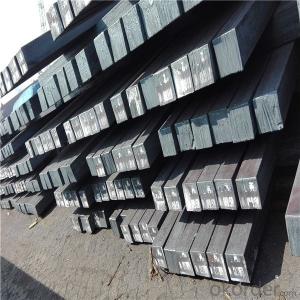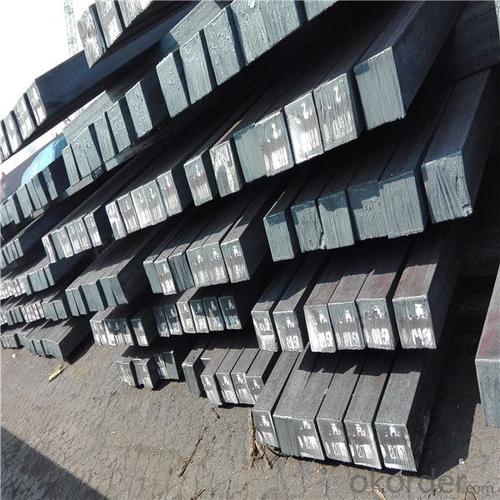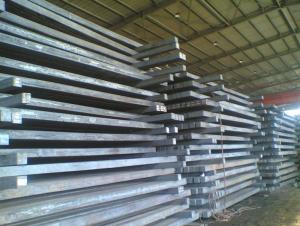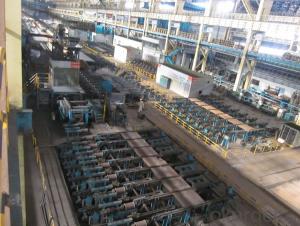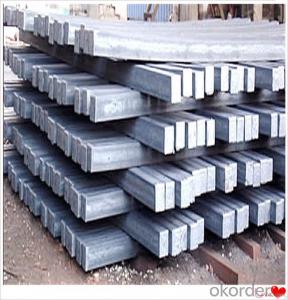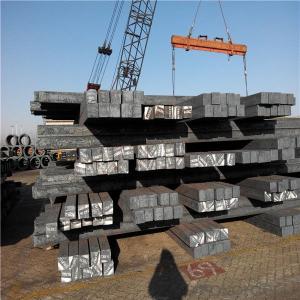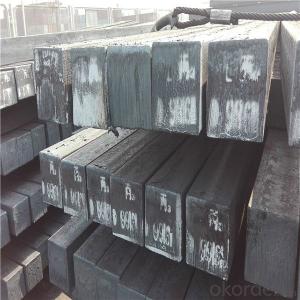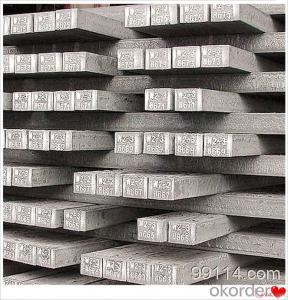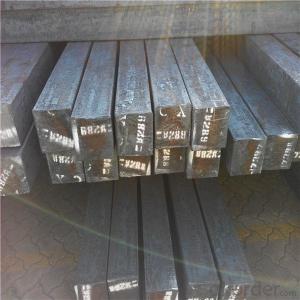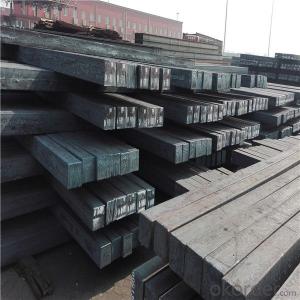Alloy Steel billets for sale Q195/Q215 China
- Loading Port:
- Tianjin
- Payment Terms:
- TT OR LC
- Min Order Qty:
- 1000 m.t.
- Supply Capability:
- 15672 m.t./month
OKorder Service Pledge
OKorder Financial Service
You Might Also Like
Specification
Rectangular billet continuous casting billet and mainly general carbon steel, low carbon low silicon cold-rolled material, high quality carbon structural steel, high strength low alloy steel, special steel, etc.
The billet is mainly divided into two kinds from the shape:
Slab: cross section width and height of the ratio of the larger, mainly used for rolling plate.
The billet is mainly divided into two kinds from the shape:
Slab: cross section width and height of the ratio of the larger, mainly used for rolling plate.
Size :100mm to 165mm
Length:6~12meters
Grade: Q195/Q215/Q235/Q275
Qaulity:own factory, stable quality
Tolerance: Strictly according to the G/B and JIS standard
Gade:
Standard | C(%) | Mn(%) | S(%) | P(%) | Si(%) |
Q195 | ≤0.12 | ≤0.50 | ≤0.040 | ≤0.035 | ≤0.30 |
Q235 | ≤0.20 | ≤1.40 | ≤0.045 | ≤0.045 | ≤0.35 |
Q275 | ≤0.22 | ≤1.50 | ≤0.045 | ≤0.045 | ≤0.35 |
20MnSi | 0.17-0.25 | 1.2-1.6 | ≤ 0.050 | ≤ 0.050 | 0.40-0.80 |
3SP | 0.14-0.22 | 0.40-0.85 | ≤ 0.050 | ≤ 0.040 | 0.05-0.15 |
5SP | 0.28-0.37 | 0.50-1.00 | ≤ 0.050 | ≤ 0.040 | 0.15-0.30 |
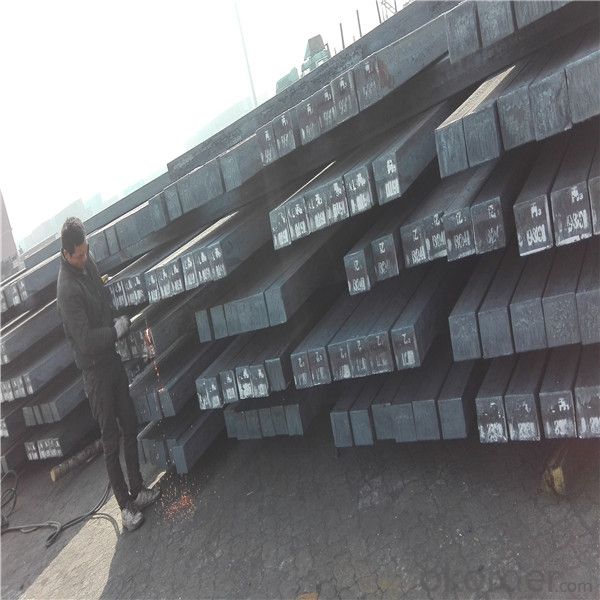
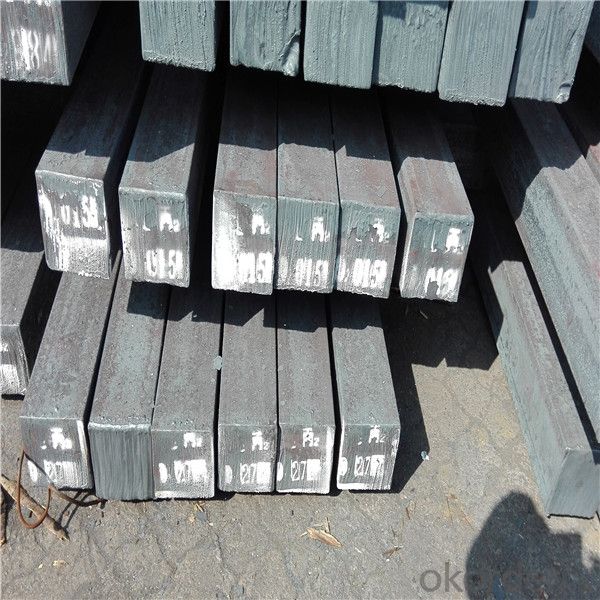
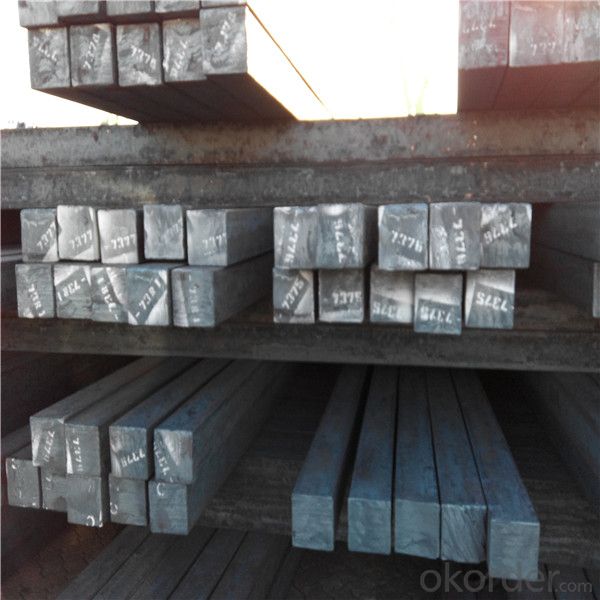
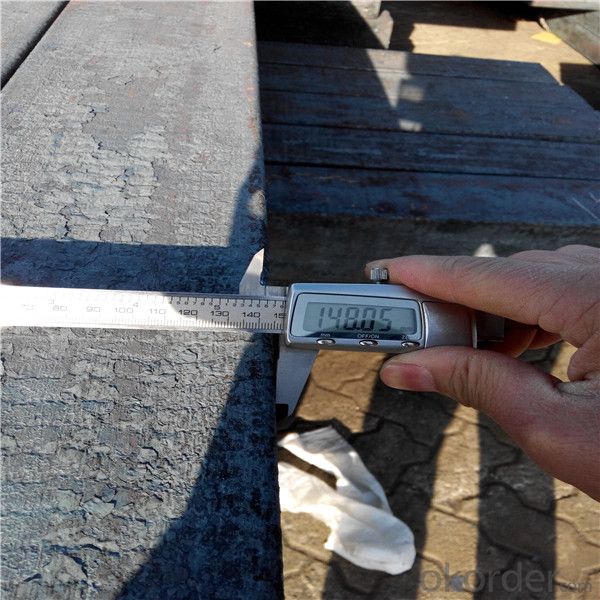
Our service :
We have a plant and professional team to provide our best service, from the start of production until the
loading into the vessel, we have a complete quality follow up procedure, to assure our products arrives to the customer with satisfaction. Welcome new and old customers
to contact us for future business relationships! We will give you a surpise price.
Packing :
Within 30 days
1.Standard export package
2.In bundles with steel strips
3.As the requirements of the customers
FAQ:
Q: What is payment terms?
A: FOB 30% T/T IN ADVANCE AS DEPOSIT AND 70% T/T BEFORE SHIPMENT
CIF and CFR 30% T/T IN ADVANCE AS DEPOSIT AND 70% T/T AS THE COPY OF B/L OR L/C AT SIGHT
Q:How to guarantee the quality of the products?
A:We have established the international advanced quality management system,every link from raw material
to final product we have strict quality test;We resolutely put an end to unqualified products flowing into the market.
At the same time, we will provide necessary follow-up service assurance.
Q:How long can we receive the product after purchase?
A :In the purchase of product within three working days, We will arrange the factory delivery as soon as possible.
The pecific time of receiving is related to the state and position of customers.
- Q: What are the potential applications of steel billets in the automotive aftermarket?
- Steel billets have numerous potential applications in the automotive aftermarket. They can be used to manufacture various critical components such as engine parts, suspension systems, and drivetrain components. Additionally, steel billets can be utilized to fabricate customized performance parts, enhancing the overall performance and durability of vehicles. Their versatility and strength make them a valuable resource for meeting the diverse needs of the automotive aftermarket industry.
- Q: What are the different surface treatments for improved surface lubrication in steel billets?
- Some of the different surface treatments for improved surface lubrication in steel billets include hot rolling, cold rolling, pickling, and applying a lubricant coating.
- Q: What is the role of steel billets in the construction of offshore platforms?
- Steel billets play a crucial role in the construction of offshore platforms. These platforms are massive structures that are installed in the open sea to extract oil or gas from beneath the ocean floor. Due to the harsh environmental conditions and the need for utmost safety and durability, steel billets are widely used in their construction. One of the primary functions of steel billets is to provide the raw material for the fabrication of various components of offshore platforms. Billets are large, semi-finished steel products that are typically used as starting material for the production of other steel products. They are cast into a specific shape, usually a square or a rectangle, and have a solid cross-section. Offshore platforms require steel with exceptional strength, corrosion resistance, and impact toughness to withstand the challenging conditions they face, such as strong waves, harsh weather, and extreme temperatures. Steel billets are often made from high-strength alloyed steels, which offer superior mechanical properties and resistance to corrosion. These billets are then further processed to manufacture different structural elements of offshore platforms, including beams, columns, braces, and other support structures. These components must be able to support the weight of the platform itself, as well as withstand the forces generated by ocean waves, wind, and the extraction process. Moreover, steel billets are also used in the production of pipes and tubes, which are vital for transporting oil and gas from beneath the seabed to the platform or to the shore. These pipes need to be strong, durable, and resistant to corrosion to ensure the safe and efficient flow of hydrocarbons. In summary, steel billets serve as the building blocks for the construction of offshore platforms. They provide the raw material for fabricating various structural components, ensuring the strength, durability, and safety of these massive structures in the challenging offshore environment.
- Q: How are steel billets forged into shape?
- The process of hot forging is utilized to shape steel billets. It entails heating the billet to a temperature that enables easy manipulation, typically ranging from 1100 to 1250 degrees Celsius. Once heated, the billet is positioned on a die, which is a specially designed tool with a cavity that imparts the desired shape onto the final product. Pressure is exerted on the billet by a large mechanical or hydraulic press, compelling it to fill the die cavity. This pressure induces the steel to flow and take the shape of the die, resulting in the intended form of the forged item. Depending on the product's size and complexity, the pressure applied during forging can reach several thousand tons. Throughout the forging process, the steel billet undergoes plastic deformation, causing its internal structure to rearrange and the metal grains to align. This grain alignment enhances the mechanical properties of the forged product, increasing its strength and durability. To achieve the final dimensions and features, additional operations such as trimming, piercing, or punching may be conducted after the initial shaping. These post-forging operations can be carried out while the steel is still hot or after it has cooled down. Once the desired shape is attained, the forged product is slowly cooled to alleviate any residual stresses and prevent cracking. This cooling process, known as annealing, enhances the metallurgical properties of the steel and improves its overall performance. To summarize, the hot forging process involves heating the steel billet, placing it on a die, applying high pressure to shape it, and subsequently cooling it to optimize its mechanical properties. This process enables the transformation of steel into various intricate shapes, making it a versatile and extensively used material across multiple industries.
- Q: How are steel billets used in the production of gears?
- Steel billets are used in the production of gears as they serve as the raw material from which gears are forged or machined. Steel billets undergo a series of processes such as heating, shaping, and cutting to transform them into the desired gear shape. The billets are carefully crafted and shaped to ensure the highest quality and durability of the gears, allowing them to effectively transmit power and perform their intended function in various machinery and equipment.
- Q: What is the role of steel billets in the shipbuilding industry?
- Steel billets play a crucial role in the shipbuilding industry as they are the primary raw material used to construct the structural components of ships. These billets, which are essentially semi-finished steel products, are produced by continuously casting molten steel into rectangular shapes that can be further processed and shaped into various shipbuilding components. One of the main advantages of using steel billets in shipbuilding is their high strength and durability. Ships are subjected to intense stress and harsh conditions, including waves, corrosion, and extreme temperatures. Steel billets provide the necessary strength and rigidity required to withstand these conditions, ensuring the structural integrity and longevity of the vessel. Moreover, steel billets offer excellent weldability, which is essential for shipbuilding. As ships consist of numerous welded joints, the ability to weld steel billets easily and reliably is crucial in achieving a strong and reliable structure. The weldability of steel billets allows for efficient and cost-effective construction methods, reducing both time and labor required for shipbuilding. Additionally, steel billets provide versatility in ship design. They can be easily shaped and fabricated into various forms and sizes, allowing shipbuilders to create complex and intricate structures that optimize space utilization and enhance functionality. This flexibility in design enables the construction of diverse types of ships, ranging from cargo vessels and tankers to cruise ships and naval vessels. Furthermore, steel billets also possess excellent resistance to corrosion, which is vital for ships that constantly operate in corrosive marine environments. The high-quality steel used in billets offers protection against rust and deterioration caused by seawater, ensuring the longevity and safety of the vessel. In summary, steel billets play a fundamental role in the shipbuilding industry by providing the necessary strength, weldability, versatility, and corrosion resistance required for constructing durable and seaworthy ships. Their use as the primary raw material allows shipbuilders to create reliable and efficient vessels capable of withstanding the challenging conditions of the maritime environment.
- Q: Is the reaction of carbon and carbon dioxide a redox reaction?
- Is the redox reflect the oxidizing agent is CO2 C 2009-10-22, the reducing agent is the oxidizing agent is CO2, is C 2009-10-22 reductant is redox reaction. Price reduction in carbon dioxide carbonation, was reduced, so is the oxidant.
- Q: What are the main factors affecting the hardenability of stainless steel billets?
- The main factors affecting the hardenability of stainless steel billets are the chemical composition of the steel, the cooling rate during heat treatment, and the presence of alloying elements such as chromium, nickel, and molybdenum. The chemical composition determines the steel's ability to form martensite, a hard and brittle phase, during quenching. The cooling rate influences the transformation of austenite, the high-temperature phase, into martensite. Alloying elements enhance the hardenability by promoting the formation of martensite and improving the steel's ability to retain its hardness upon cooling.
- Q: How do steel billets contribute to the automotive industry?
- The automotive industry heavily relies on steel billets as the primary raw material for manufacturing different automotive components. These components, including engine parts, transmission systems, chassis, suspension systems, and other critical parts, are crucial for ensuring the safety, performance, and durability of vehicles. A significant contribution of steel billets to the automotive industry lies in their exceptional strength and durability. Steel is widely known for its high tensile strength, which enables it to withstand extreme forces and provide structural integrity to automotive components. This strength is particularly crucial in areas such as the frame, where it ensures passenger safety in the event of a collision. Moreover, steel billets offer excellent formability and versatility, allowing manufacturers to create intricate and complex automotive parts with precision. This enables the production of components that meet the specific design requirements of different vehicle models, ensuring optimal performance and functionality. Another advantage of steel billets is their cost-effectiveness. Compared to alternatives like aluminum or carbon fiber, steel is a relatively affordable material. Its widespread availability and production efficiency make it an economical choice for mass production, helping to keep vehicle prices reasonable for consumers. Furthermore, steel billets possess excellent heat resistance and thermal conductivity properties, making them ideal for use in engine components, such as pistons and cylinder heads. They can withstand high temperatures and efficiently transfer heat. Additionally, steel billets contribute to the sustainability of the automotive industry. Steel is highly recyclable, with a recycling rate of around 90%. This allows for the eco-friendly disposal and reuse of steel components, reducing the environmental impact of the automotive manufacturing process. In conclusion, steel billets play a crucial role in the automotive industry by providing the necessary strength, durability, formability, and cost-effectiveness for manufacturing various automotive components. Their versatility and recyclability further contribute to the sustainability of the industry. Without steel billets, the automotive industry would face challenges in producing safe, reliable, and affordable vehicles.
- Q: What are the advantages of using steel billets in manufacturing?
- Using steel billets in manufacturing processes has numerous benefits. Firstly, they offer exceptional strength and durability, making them ideal for applications that require heavy loads or resistance to wear and tear. This ensures that products made from steel billets are long-lasting and can withstand harsh conditions, reducing the need for frequent replacements. Secondly, steel billets are highly versatile, allowing manufacturers to easily mold and shape them into various forms. This versatility enables the creation of a wide range of products with different designs and specifications, making steel billets suitable for industries such as construction, automotive, machinery, and appliances. Furthermore, steel billets are cost-effective due to the affordability and widespread availability of steel. This ensures a steady supply and reduces production costs. Moreover, steel's durability minimizes maintenance and replacement expenses, resulting in long-term savings. Another advantage of using steel billets is their eco-friendliness. Steel is highly recyclable, promoting sustainability in the manufacturing process. By recycling steel, the need for mining raw materials is reduced, energy is conserved, and carbon emissions are decreased. Therefore, steel billets contribute to a greener manufacturing process and support environmental conservation efforts. Lastly, steel billets offer excellent performance characteristics. They have exceptional thermal and electrical conductivity properties, making them suitable for applications requiring heat dissipation or electrical conduction. Additionally, steel is resistant to corrosion, rust, and fire, providing an extra layer of protection to products manufactured using steel billets. In conclusion, the advantages of using steel billets in manufacturing include their strength and durability, versatility, cost-effectiveness, eco-friendliness, and exceptional performance characteristics. These advantages make steel billets a preferred choice for various industries, ensuring high-quality products that withstand the test of time.
Send your message to us
Alloy Steel billets for sale Q195/Q215 China
- Loading Port:
- Tianjin
- Payment Terms:
- TT OR LC
- Min Order Qty:
- 1000 m.t.
- Supply Capability:
- 15672 m.t./month
OKorder Service Pledge
OKorder Financial Service
Similar products
Hot products
Hot Searches
Related keywords
